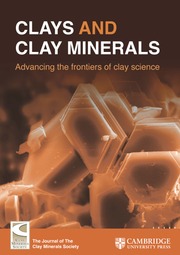Article contents
Segregation and Exchange Properties of Alkylammonium Ions in a Smectite and Vermiculite
Published online by Cambridge University Press: 01 July 2024
Abstract
X-ray diffraction analysis of mixed alkylammonium-exchanged smectite revealed segregation of different ion species into randomly ordered layers. Vermiculite, however, showed segregation into crystallites, a behavior attributed to clay inhomogeneity. Ion segregation is explained by the hydration properties of cations as well as the energy requirements of layer expansion. Quaternary ammonium ions of different size were used to exchange ethylammonium-clays, and the effectiveness, as well as steric hindrance, of cation size in ion exchange was demonstrated. Layer charge density was related to the degree of ease of large cation adsorption. Basal spacing in suspension was found to be important in determining the preference of vermiculite for certain cations, while more freely-expanding, lower layer charge smectite did not demonstrate this phenomenon.
Résumé
L’analyse par diffraction X d’une smectite partiellement échangée par des ions alkylammonium révèle une ségrégation des différentes espèces ioniques dans des feuillets ordonnés au hasard. La vermiculite, au contraire, montre une ségrégation dans des cristallites; ce comportement est attribué à l’hétérogénéité de l’argile. La ségrégation ionique est expliquée par les propriétés d’hydratation des cations et par l’énergie requise pour l’ouverture des feuillets. Des ions ammonium quaternaire de différentes tailles ont été utilisés pour échanger des argiles etylammonium et on a pu démontrer l’efficacité et le rôle dans l’empêchement stérique de la taille du cation lors de l’échange d’ion. La densité de charge du feuillet a été reliée à la facilité avec laquelle le gros cation est adsorbé. Il a été montré que l’espacement basal en suspension joue un rôle important pour déterminer la préférence de la vermiculite pour certains cations alors que la smectite à plus basse charge et à caractère de gonflement non limitéplus marqué, ne met pas ce phénomène en évidence.
Kurzreferat
Die Röntgenbeugungsanalyse von Smectiten, die mit gemischten Alkylammoniumionen ausgetauscht wurden, ließ eine Auftrennung der verschiedenen Ionenarten in zufällig geordnete Schichten erkennen. Vermiculit zeigte dagegen Auftrennung in Kristallite. Dieses Verhalten wurde auf Inhomogenität des Tons zurückgeführt. Die Auftrennung der Ionen wird sowohl mit den Hydratationseigenschaften der Kationen als auch mit dem Energiebedarf für eine Schichtaufweitung erklärt. Quarternäre Ammoniumionen verschiedener Größe wurden mit Äthylammonium-Ton zum Austausch gebracht und der Wirkungsgrad sowie die durch die Kationengröße bedingte sterische Hemmung des Ionenaustausches dargestellt. Zwischen der Ladungsdichte der Silicatschichten und dem Ausmaß des Eintausches großer Kationen bestand eine Beziehung. Der Basisebenenabstand in Suspension stellte sich als wichtige Bestimmungsgröße der Selektivität von Vermiculit für bestimmte Kationen heraus. Smectit mit niedrigerer Schichtladung zeigte diese Erscheinung nicht.
Резюме
При рентгеновском исследовании смешанного смектита с обмененным алкиламо-нием обнаружили сегрегацию различного рода ионов в произвольно регулярные слои. Вермикулит, однако, выявил сегрегацию в мелкие кристаллы; это поведение приписывается неоднородности глины. Сегрегация ионов объясняется как свойствами гидрации катионов, так и энергией разложения на слои. Для обмена этиламмониевых глин использовались четвер¬тичные аммониевые ионы различных размеров, что продемонстрировало как эффективность, так и стерическое препятствие размера катионов в ионообмене. Плотность заряда слоя соответствовала легкости адсорбции крупных катионов. Нашли, что базальный параметр в суспензии является важным фактором причины предпочтения вермикулитом некоторых катионов, в то время как смектит, разлагающийся более свободно, этой особенности не проявляет.
- Type
- Research Article
- Information
- Copyright
- Copyright © 1973 The Clay Minerals Society
Footnotes
Journal Article No. 6166. Michigan Agricultural Experiment Station, Michigan State University, East Lansing, Michigan 48823, U.S.A.




